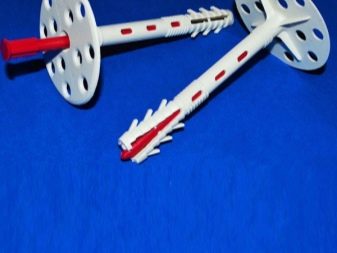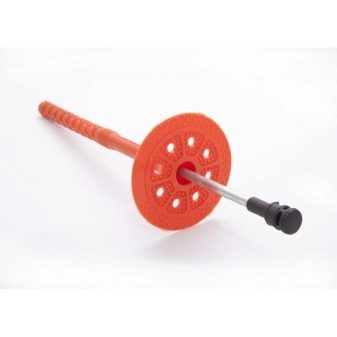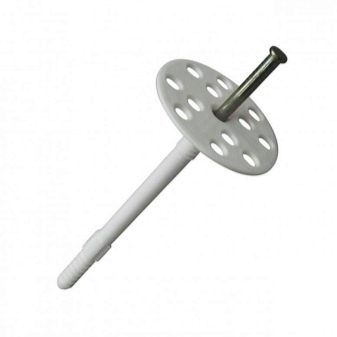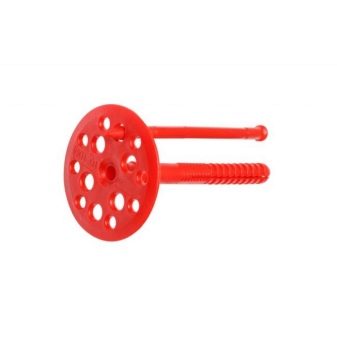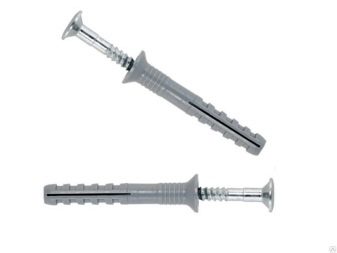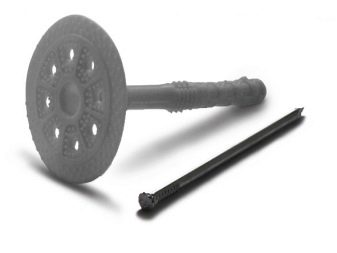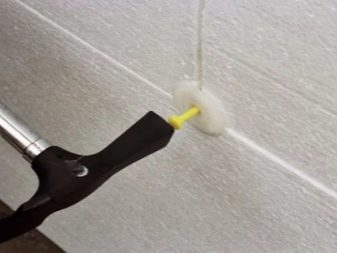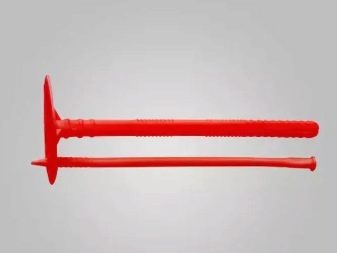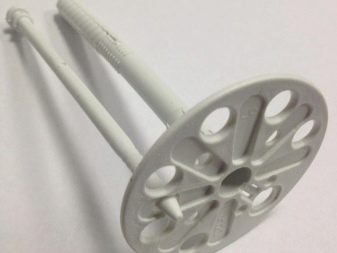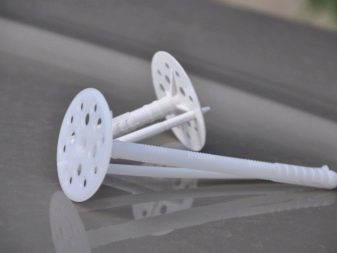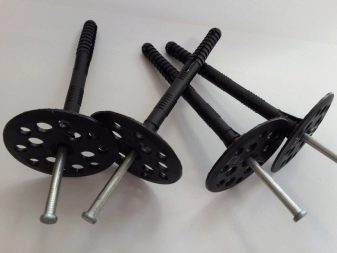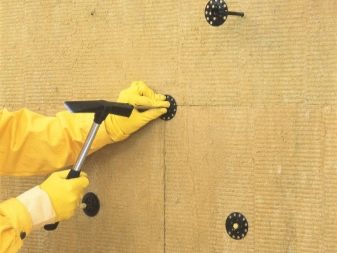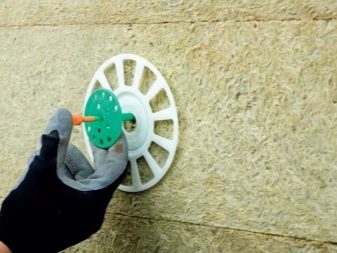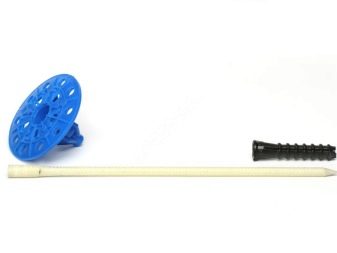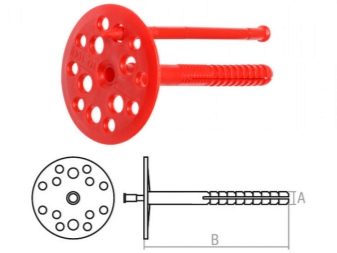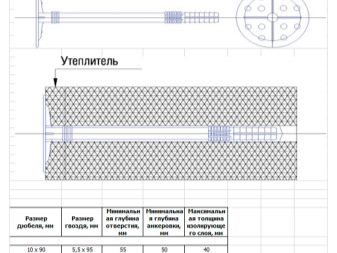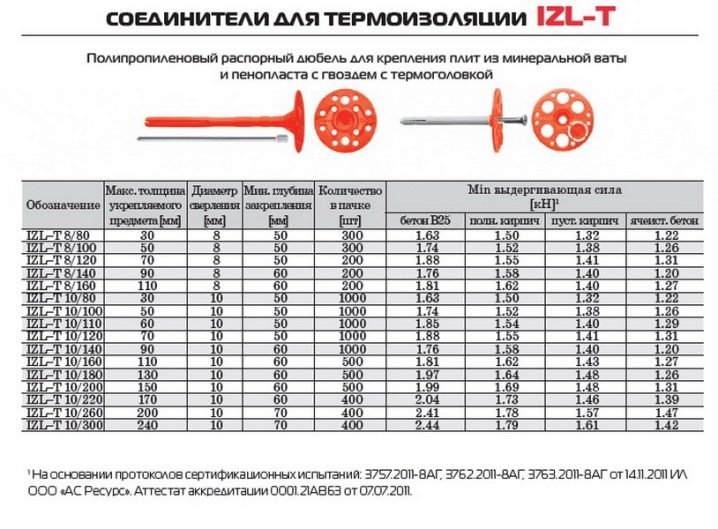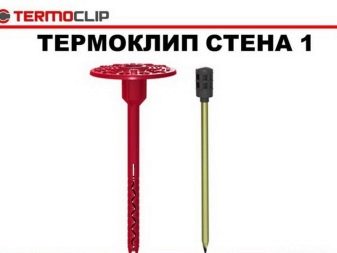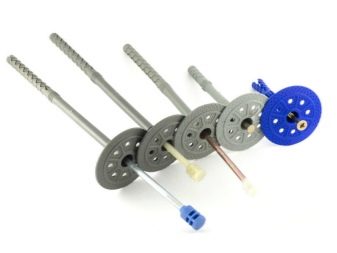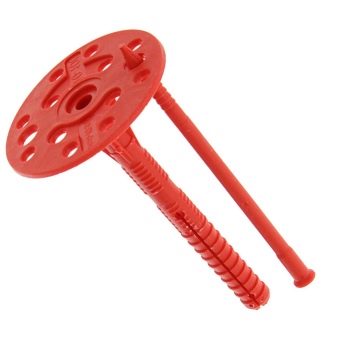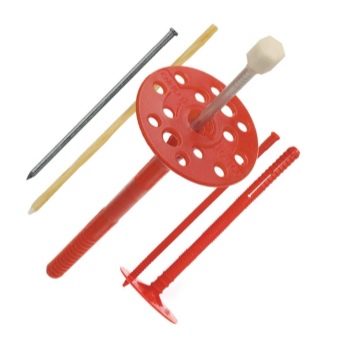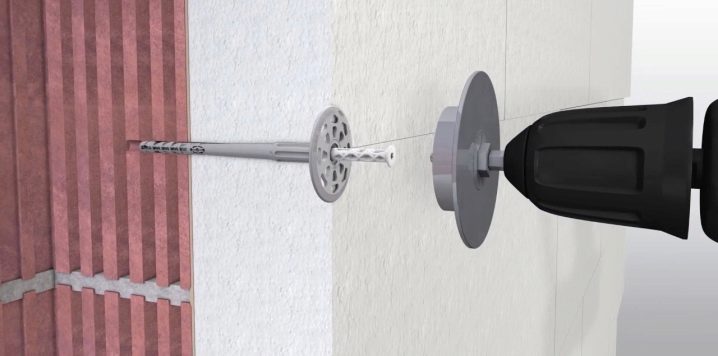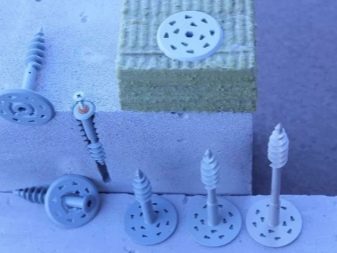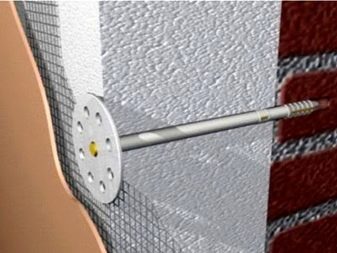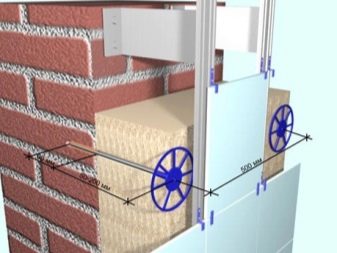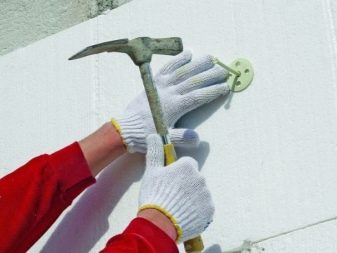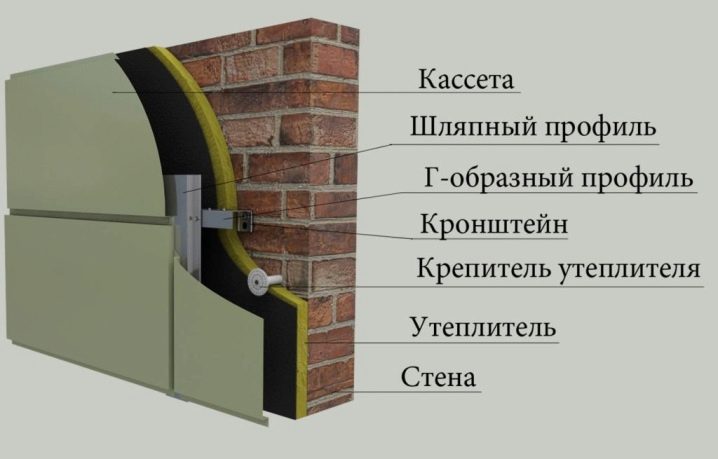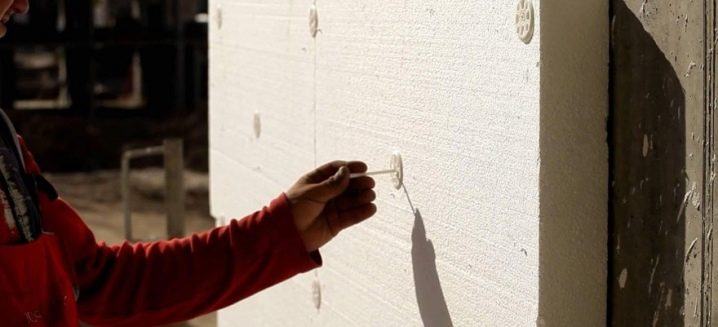Dowels for thermal insulation: types of fasteners and features of choice
Performance of work on weatherization of the facade of the building involves the solution of the main task - the installation of thermal materials. For installation, you can use an adhesive solution, but when performing a large amount of work and to increase the reliability of the structure, it is better to use a special dowel-nail or a dish-shaped dowel.
Special features
Dowel plugs can be visually divided into three conventional parts - a cap, an ordinary probe rod and a spacer zone. A distinctive feature of a flat-bottomed dowel head is a diameter from 45 to 100 mm. This constructive solution allows you to securely fix the insulation to the facade of the building. The cap has a rough surface and is equipped with cone-shaped technological holes to enhance adhesion to the insulation.Under the bonnet there is an ordinary zone of the rod, ending with a spacer zone, which is responsible for fastening the entire insulation system to the facade and consists of several sections. The length of the section depends on the dimensions of the disc plug itself and averages 60 mm. The disc dowel also includes a retaining nail or screw that fixes the dowel due to the expansion of the expansion space.
Kinds
Dowels for manufacturing materials, characteristics and applications can be divided into the following types:
- with plastic nail - used for fastening lightweight structures, entirely made of nylon, low pressure polyethylene or polypropylene;
- with a metal rod - incorporates a metal expansion nail, which significantly increases its reliability;
- with a metal rod and a thermal cover - in addition to the metal expansion nail there is a thermal cover to reduce heat transfer;
- front dowel with fiberglass rod - model designer, expansion nail made of high strength fiberglass.
Based on the type of attachment, we can additionally distinguish the following types:
- dowels with durable rod - can be hammered with a hammer, which significantly speeds up the installation process;
- Dowels with embossed caps - designed for installation only with a screwdriver or screwdriver.
Specifications
Each product from the list above has its own unique properties and each has its own positive and negative qualities. Before purchasing a sufficient amount of fastening material, it is necessary to familiarize yourself with the characteristics of each type of dish-shaped dowels:
- Dowels with plastic nail. It is made from nylon, low pressure polyethylene or polypropylene. By their properties, these materials are virtually identical, so they should not affect the adoption of a positive decision when choosing fasteners. Since this fastening material is entirely made of plastic, it is very light, which allows it to be used in any design without worrying about the load on the supporting wall. But there is another side to this - with their help, it is not necessary to fix a heavy insulation, they simply will not stand it.
The absence of metal in the composition of the expansion nail gives it additional advantages - immunity to moisture and low thermal conductivity.The first advantage makes it immune to corrosion and increases the service life up to 50 years, and the second - allows you to minimize heat loss. At the same time, during installation, utmost care should be taken when working with a plastic spreader nail. Possessing low rigidity, it has an unpleasant feature to bend and break at the most inappropriate moment.
- Dowels with metal nail. It differs from the previous model in that it uses a metal nail made of galvanized steel with a thickness of 6 mm as a fastener. This significantly increases the strength and allows you to withstand the weight of any structures and use when working with any type of insulation. And unlike plastic metal, the spacer nail will not break and will not bend. But this type of disc dowel has drawbacks. Metallic nail nail better than plastic conducts heat and can create areas on which the wall can freeze, which will not happen when the dowel, entirely made of plastic. The second drawback is corrosion. If the wall remains wet for most of the year, then the entire expansion nail will pass through the unprotected rust cap, which will lead to the failure of the entire insulation system.
- Dowel pin with a metal core and a thermal lid. This is an improved version of the previous fasteners, designed to work in conditions of high humidity. The main difference is the plastic cap, which is attached to the cap of the dowel. It prevents the penetration of moisture and reduces the outflow of heat, so this fastener can be considered more tight. There are two versions - with a removable plug, which must be installed independently, and a plug installed at the factory. The second option is more convenient in work, because the plugs are rather small and are stored separately. During the work they are easy enough to lose.
- Facade plug with fiberglass rod. This species appeared on the market relatively recently. It is assembled from the following elements - clamping part, fiberglass rod, anchor element with spacer zone and expansion washer, which is worn on the clamping part to create an additional area for fixing insulation. Thanks to a fiberglass rod, the dowel has high strength and low thermal conductivity.All these elements can be selected separately, being guided only by the necessary sizes.
There must be a certificate of quality insulation panels. Today, species such as fungi and an umbrella are often used. The mushroom can be screw, IZL-T and IZM.
Dimensions
The dimensions of the elements of the dish-shaped dowels vary depending on the type, purpose and manufacturer. The definition of dowel-nail and dish-shaped dowel is absent in the GOSTs; therefore, it is impossible to attach to state standards. Therefore, below are the average sizes by type of fasteners.
Plastic nail plug has the following dimensions:
- the length of plastic fasteners ranges from 70 to 395 mm;
- diameter of the expansion nail - from 8 to 10 mm;
- the diameter of the disc element is 60 mm;
- insulation thickness for installation should vary from 30 to 170 mm;
The dowel with metal nail has the following dimensions:
- the length of the plastic fastener is from 90 to 300 mm, which is the standard parameters;
- the diameter of the disc element is 60 mm;
- the diameter of the metal expansion rod (nail) - from 8 to 10 mm;
- insulation thickness can be from 30 to 210 mm.
Manufacturers Overview
Today, the leading manufacturers of disc dowels are enterprises of Russia, Poland and Germany. Taking into account the order of the President of the Russian Federation Vladimir Vladimirovich Putin "On the implementation of the import substitution program", you should pay attention to the three domestic leading companies that produce dish dowels:
- Termoklip - it is a trade and production company, which in the markets of Russia and the CIS countries presents several series of dish-shaped dowels made of a block polymer based on high molecular weight polyethylene. The metal elements are made of carbon steel with a resistant anti-corrosion coating. Some models are protected by a thermal insulation cover.
- Isomax - this company produces disc plugs with a diameter of 10 mm with a galvanized nail and the possibility of installing a thermal head. The metal nail is made of carbon steel with an electro galvanized coating.
- Tech-Krep - This is a Russian company that manufactures plastic dish-shaped dowels with several versions: with plastic and metal nails, with and without thermal insulation cover.Dowels are made from primary raw materials using a complex chemical composition. Metal nails are made of steel with hot-dip galvanized coating.
How to calculate?
For reliable fastening of insulation, it is first necessary to correctly calculate the size of the dowel rod. For calculations, you must use the following formula:
L (rod length) = E + H + R + Vwhere:
- E - the length of the expansion piece of the dowel rod;
- H is the thickness of the insulation;
- R is the thickness of the adhesive solution (if necessary, gluing);
- V - the deviation of the facade from the vertical plane.
The number of dowels used for the installation of insulation directly depends on its weight. For example, penoplex can be strengthened with 4 dowels per 1 m², and for basalt wool it is necessary from 6 pieces. The exact amount is calculated in the process of calculating the surface area to be insulated.
The formula for calculating the total fastener consumption is as follows:
W = S * Q, Where:
- S is the total surface area;
- Q - the number of dowels per 1 m² of insulation.
To the final calculation, you need to add an additional 6–8 pieces in case of unforeseen expenses (loss or breakdown).When calculating the flow, you should additionally take into account that, unlike walls, more fasteners go to corners. Therefore, in addition, you need to add another 10-15 pieces. The basic costs of fasteners per square meter may be different. You can spend as 90 dowels, and 140, 160, 180 and even 200.
Application tips
When choosing dish-shaped dowels one should pay attention to some nuances:
- if installation of penoplex will occur, then the choice should be stopped on varieties with a rough hat;
- It is worth paying special attention to the quality of anti-corrosion treatment, if there is a risk of precipitation getting inside the heat-insulating structure;
- when insulating high-rise buildings, the most expensive models of plate-shaped dowels with a metal nail and plastic thermal head should be purchased, which protects the structure from moisture ingress;
- to the preferred performance characteristics, in addition to maintaining the total mass of the structure, its own weight and dimensions, and also should be added to the temperature range of operation;
- in northern latitudes under extreme weather conditionsIt is undesirable to use plastic disc with a plastic spacer rod in the installation of outdoor insulation. The fact is that at extremely low temperature and humidity drops there is a serious risk of their cracking and further destruction of the entire thermal insulation system. In such a situation, preference should be given to the dish-shaped dowel with a metal rod and thermo lining or to the front dish-shaped dowel with a rod made of fiberglass.
Dowels are used for the installation of insulation on the facades of industrial, commercial and residential premises. The installation process itself can be divided into the following steps:
- marking the installation area of insulation;
- drilling holes through the insulation;
- installation of the dowel in the mounting hole until the cap is completely drowned in the insulation;
- setting the nail for thrust and clogged it to the required level.
It is worthwhile to dwell in more detail on the technical aspects of the insulation procedure.
- Before you begin, you must prepare the original surface. To this end, all depressions and protuberances are eliminated until a flat surface is obtained.Then, the insulation is attached to the working surface with a special adhesive mixture. If the surface is fairly flat, then a notched trowel can be used to form.
- So that the first row of insulation does not fall below the mass of the subsequent ones, the starting level is fixed in the lower part. Sheets will be based on it. Then, after the adhesive mixture is completely dry (about 2–3 days), the sheets are finally attached with plate-shaped dowels. At the beginning, holes are made in previously marked places using a perforator.
- It is imperative that the support points at which the fasteners will be made be at the joints of the sheets - this way it will be possible to prevent the appearance of additional holes for unwanted heat exchange, while at the same time, after the installation is completed, the edges of the plates will not be bent.
- Then, heat-insulating material is stitched with a dish-shaped dowel to the base of the cap. The expander nail is hammered in such a way that the cap is as tight as possible against the thermally insulating material. It is important that the dowel dive into the base by at least 1.5 centimeters.
- Then, all the joints should be carefully preserved with the help of thermo-reflective metallizedscotch tape If gaps remain more than 0.5 centimeters, they can be blown out with construction foam. But this procedure should be carried out with utmost care, as some types of foam can dissolve a polymeric heat insulator.
- Dowels are attached only once. If you make a mistake in the calculations and pull the dowel out of the wall, it will collapse. To avoid this, you must be very serious about preparing the seat. Inside there should not be cracks, chips, sand, dust and other debris. The hole is drilled to the diameter of the selected fasteners. The depth should be 0.5–1 cm longer than the selected element.
- After fixing the heat-insulating material, rather deep holes remain in it, which must be repaired with a paint spatula.
If you follow all these tips and work order, then facade insulation will take a minimum amount of time, and the production process will be as productive as possible.
To learn how to properly fix the insulation to the walls with a dowel, see the following video.



